Practicing leash skills can help walks and other leashed activities be enjoyable and safe for both you and your pup.
In this guide, we’ll talk about rethinking expectations of our canine companions, discuss what we can do to support their well-being while leashed, and cover practical leash skills.
Read on to learn more.
Defining a “Well-Behaved Dog”
Before we jump into talking about leash skills, let’s talk about our concept of what a “well-behaved dog” looks like. Often, we humans conceptualize and talk about the ideal behavior of dogs in relation to what best serves us and our desires. But, are the ideal behaviors we talk about and conceptualize actually what’s best for our canine companions?
In recent years, forward-thinking folks in the dog behavior and training world have been talking about how we often treat dogs with the Victorian-era concept of “children should be seen and not heard”. Folks often think a “good” dog is a silent dog, an obedient dog, and a dog who certainly doesn’t pull, walk ahead, or veer off the path to sniff on walks.
But, in silencing our dogs, in demanding that they always walk in heel with us in a straight line, and insisting that they don’t “waste our time” by sniffing on their walks, we are often actually creating behavioral symptoms by suppressing the dog’s ability to fully express themselves and process the world around them.
When thinking about teaching leash skills, it’s crucial to question whether some of the behaviors that we often seek out or are told to seek out are actually serving the species-specific and individual needs of the dog.
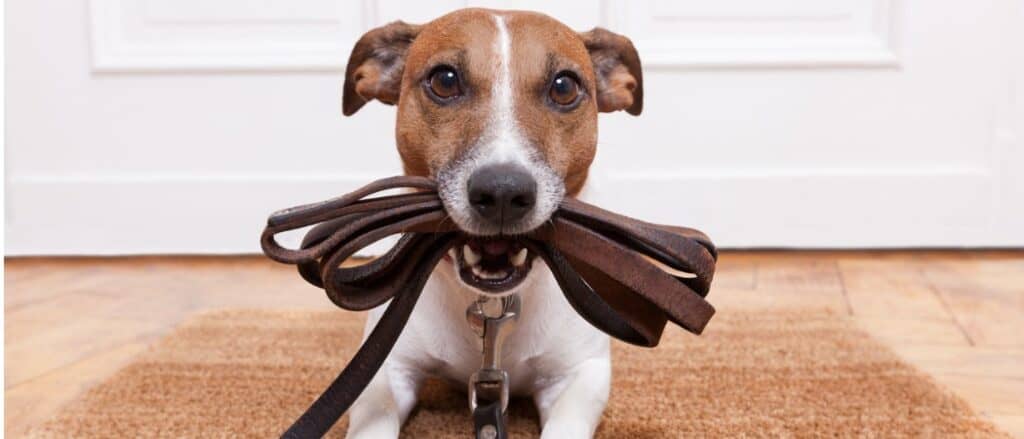
When walking our canine companions, it’s crucial to support allowing them to safely express their natural behaviors. Afterall, it’s their walk.
©Javier Brosch/Shutterstock.com
Leash Training: Do Dogs Always Need Walks?
Firstly, speaking of thinking about the individual dog, let’s ask a question that may seem a little silly at first. Why do we take our dogs on walks, and do we always need to? For some, the answer may be because they live in an apartment complex, and taking their dogs on walks is how they provide bathroom breaks, some exercise, and the ability to sniff outdoors.
For others, the answer may simply be because the dog industry has told us over and over again that we need to walk our dogs twice a day. But, do we? In her best-selling book Stop Walking Your Dog: A Guide to Training Your Nervous, Reactive, Or Over-Excited Pup, Nikki French explains why going on walks may actually not benefit sensitive pups who struggle with fear, anxiety, or difficulty processing and regulating their emotions when out and about. Check out an interview with Nikki French here on the Dog-Centered Care youtube channel.
If Your Dog Doesn’t Enjoy Walks: Alternatives
If your pup seems stressed, over-aroused, afraid, or fearful during your walks, try to take a break from your normal walks if you can find an alternative. Instead, depending on where your dog feels safe, you can use your own yard, seek out a friend’s yard, use a private dog park service, or drive your pup to a quiet, more secluded location for low-stress walks.
At the same time, you may want to schedule a checkup with your vet to ensure that pain or illness isn’t the root of or a compounding factor in your dog’s behavioral symptoms. You can also contact a qualified force-free dog behaviorist who can help determine if taking your specific dog on walks is a necessary and realistic goal, and if it is, can facilitate steps to help your dog feel safer and more confident on their walks.
At Home Activities
If it makes more sense to not take your sensitive dog on walks, you can get creative with enrichment at home to ensure your dog’s needs for sniffing, play, social interaction, and exercise are still being met. For example, you can play scent-based games like hiding treats around the house, spray novel dog-friendly smells for your pup to investigate on their toys and in the grass, and invest in puzzle feeders, snuffle mats, lickimats, and kongs for enrichment.
For exercise and play, you can set up obstacle courses in the yard or indoors, play tug-of-war and fetch, and play stair games and hide-and-seek in non-slip environments.
If your pup has dog friends, you can set up play dates at your home or theirs if your pup feels safe going to their house. You can also set aside daily quiet, quality time with your dog where you have no distractions and you can just enjoy spending time together.
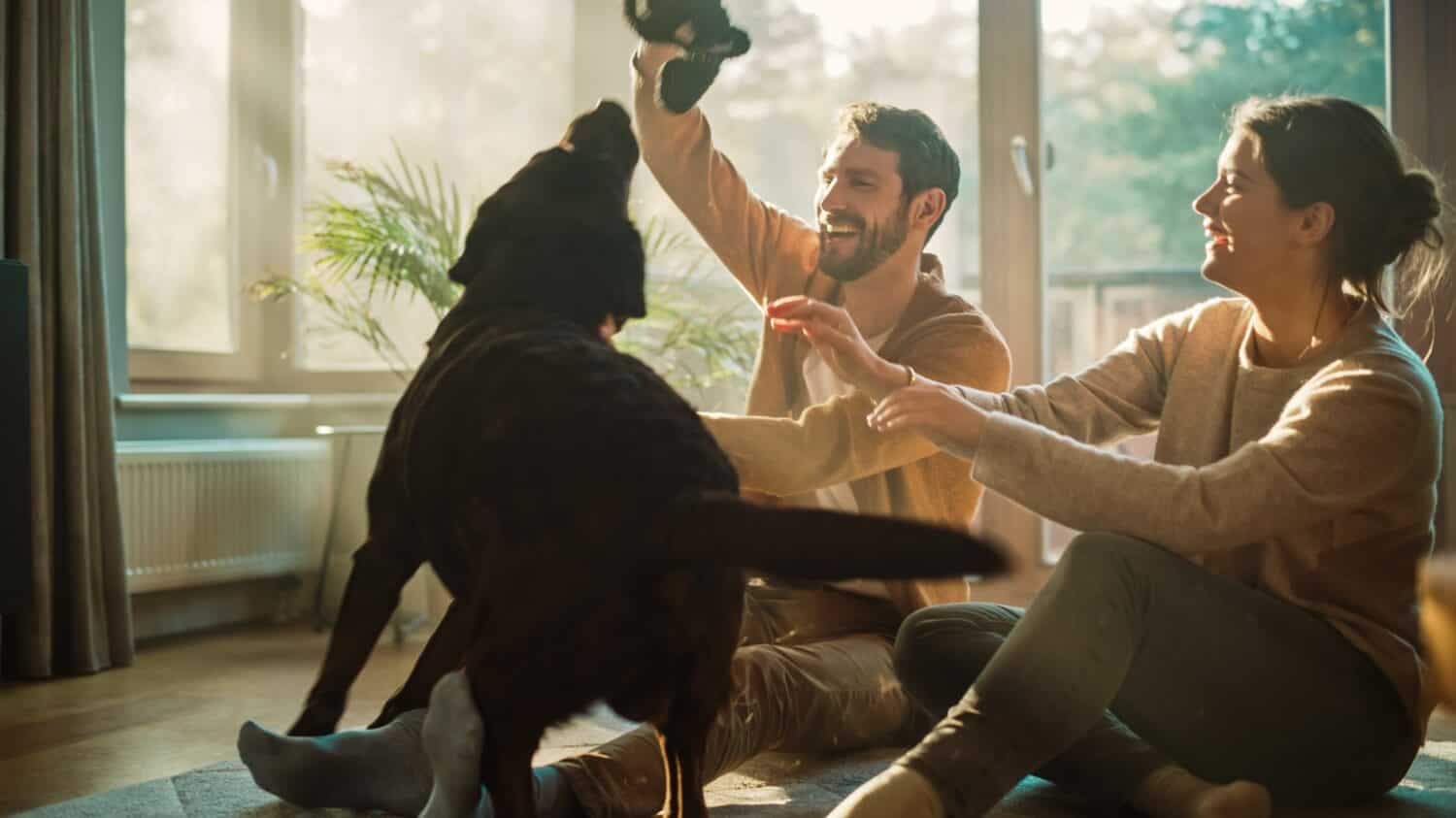
Playing with toys at home is just one of many alternative activities for dogs who don’t enjoy walks in public.
©Gorodenkoff/Shutterstock.com
Leash Training: If Your Dog Enjoys Walks
Now, If your dog enjoys going on walks you’ll want the experience to be safe, fun, and low-stress for both of you. We don’t usually enjoy being dragged down the street by an excitable pup, so facilitating leash skills is important to keep everyone happy and safe.
What Do Dogs Need for an Enjoyable Walk?
As we said above, it’s important to set up leash skills in a way that allows the dog to express safe, natural behaviors. Walking in a straight line, at a heel, and being unable to sniff as they go is about as unnatural for a dog as it gets.
Let Them Sniff!
Scenting is the primary way that dogs process the world around them. While we have about 6 million olfactory receptors in our noses, dogs have about 300 million!
So, allowing your dog to take their time and sniff as they walk is vitally important to the mental, physical, and emotional well-being of your pup. Not allowing our pups to process can actually contribute to the development of the frustration, anxiety, or fear-based “reactivity” behaviors that many dogs display on walks.
If your dog chooses to spend the majority of their walk sniffing, rather than covering a lot of distance, please allow them to. Remember, this is their walk, and giving them as much choice and autonomy as safely possible on their walks directly supports their well-being.
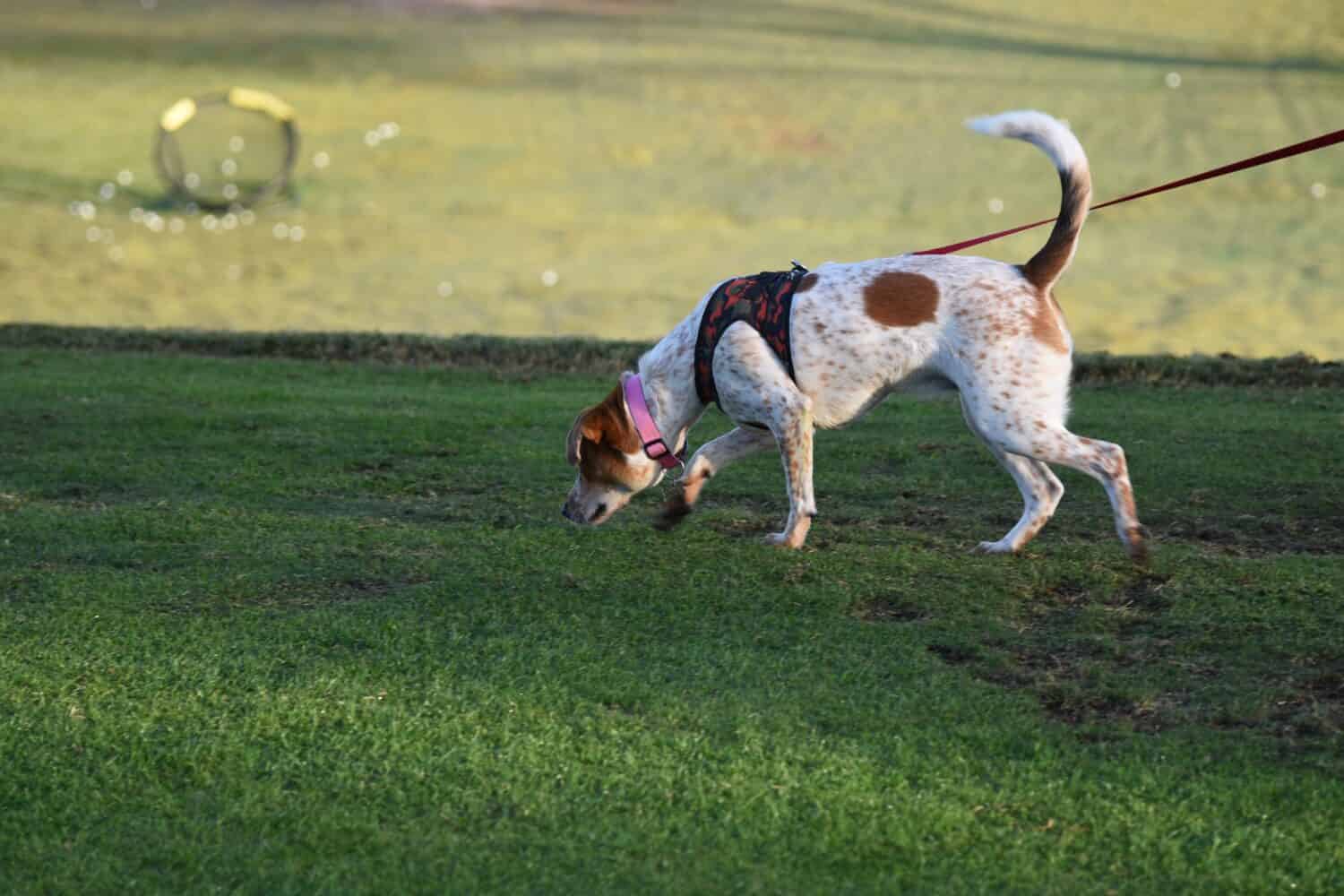
Allowing your dog to sniff on walks lets them process their environment and decompress.
©Thomas Trompeter/Shutterstock.com
If They So Choose, Let Them Lead!
The next crucial aspect of a dog-centered walk is giving them a choice whenever possible in whether they walk next to or ahead of you. You may hear some people, including dog trainers, say that you should never let your dog walk ahead of you. They’ll say this means your dog is controlling you and being “dominant”. There’s not an iota of scientific evidence to support this kind of statement and dominance theory has been thoroughly debunked. It’s also important to know that the dog training industry is unregulated, so anyone can call themself a professional dog trainer, and can give you “professional” advice that is ethically and scientifically incorrect.
However, what science does support time and time again, is that choice is crucial to the well-being of sentient beings. Emphasizing choice in your dog’s walk also means allowing them to choose paths and directions when safe to do so. Below, we’ll discuss how to facilitate allowing your dog to walk ahead and choose the paths on walks without getting pulled.
Leash Training for Walks and Other Events
Whether your pup goes on daily walks or not, teaching them leash skills is important to their safety in our human-dominated world. Below, we’ll talk about fundamental skills to help our dogs walk safely on a leash.
Equipment
First off, let’s talk about the equipment we shouldn’t be using. Prong collars, choke collars, shock collars, and head harnesses rely on creating aversive stimuli to control your pup that can range from startling to quite painful for your dog. Let’s make sure we’re starting out with a welfare-oriented and ethical base by using only comfortable, non-aversive equipment.
Harnesses and collars should fit comfortably, allow for a full range of movement, and not rub or cause discomfort. While a 6-foot lead is the typical length of most leashes, 12 to 30′ leads allow for much greater freedom of movement for your dog. When needing to navigate close-quarter or chaotic environments, you can simply coil the lead to the desired length. By using these long leads, you can allow for more choice and autonomy in safe environments.
Whenever you introduce new equipment to your pup, make sure to move at your dog’s pace of comfort. You can pair the introduction of the equipment with tasty treats to help form a positive association.
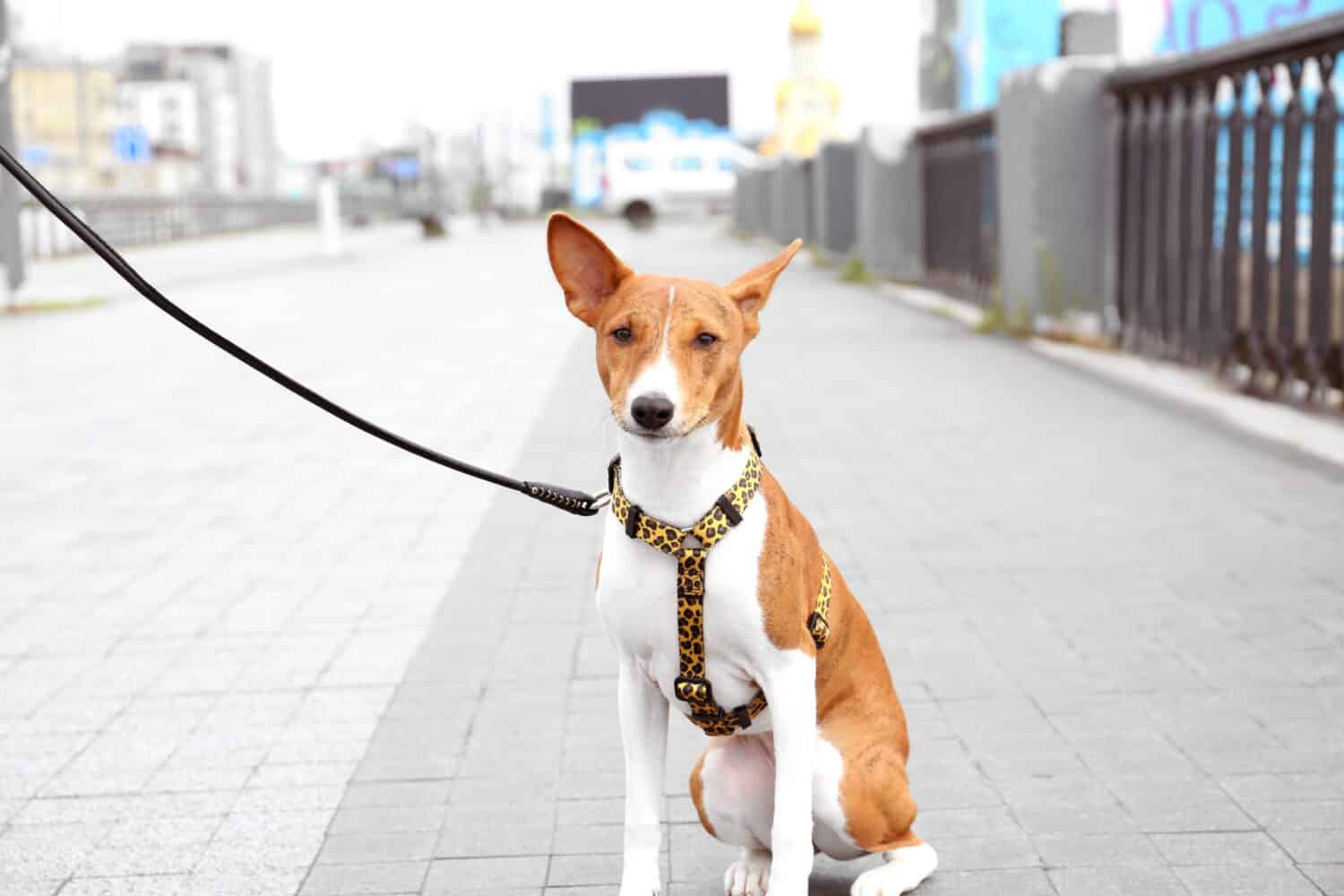
Using comfortable equipment is crucial.
©New Africa/Shutterstock.com
Positive Reinforcement and Connection Building
Positive reinforcement and connection building are crucial aspects of teaching leash skills. The more connected your pup is to you and the stronger secure attachment bond you have, the easier a time you will have in encouraging your canine companion to check in with you during walks and not drag you down the street. By building attunement with each other through facilitating a secure attachment relationship, your canine companion will be more likely to want to remain near you and check back in while on leash.
In addition to facilitating a secure attachment bond, you can also use positive reinforcement, the addition of a pleasant and motivating reward in response to a desired behavior.
Leash Training: Start in a Low-Distraction Environment
When you first start teaching leash skills, whether this is for a 10-week-old puppy or a 5-year-old dog, you’ll want to start in a very low-distraction environment where the dog feels safe. Remember, we’re talking about an environment that isn’t just physically safe for the dog, but where the dog actually feels safe and secure. Just like us, dogs can best learn and engage the cognitive side of their brain when they feel safe and secure.
Start Teaching “Check-Ins”
Start by simply hanging out with the leash on and letting your pup explore the space. Make sure the leash is nice and loose, and allow your dog to choose where they go. Every so often, call their name and immediately give them a tasty treat when they stop and look at you. You can slowly increase the frequency of calling their name. By doing this repeatedly, you’re building a strong history of your dog checking in with you. You can use these check-ins on walks to call your pup before they hit the end of a leash. Often, dogs will simply offer these check-ins before you even call their name because you’ve built a rewarding history with this behavior.
Slowly build this skill in more distracting environments. It’d be a lot to ask of your dog to go straight from checking in within a low-distraction space to being that responsive when surrounded by novel stimuli. Both positive reinforcement and a secure attachment relationship will help develop this skill. Additionally, using comfortable equipment and a leash length that allows for more freedom of movement will help set you and your pup up for success.
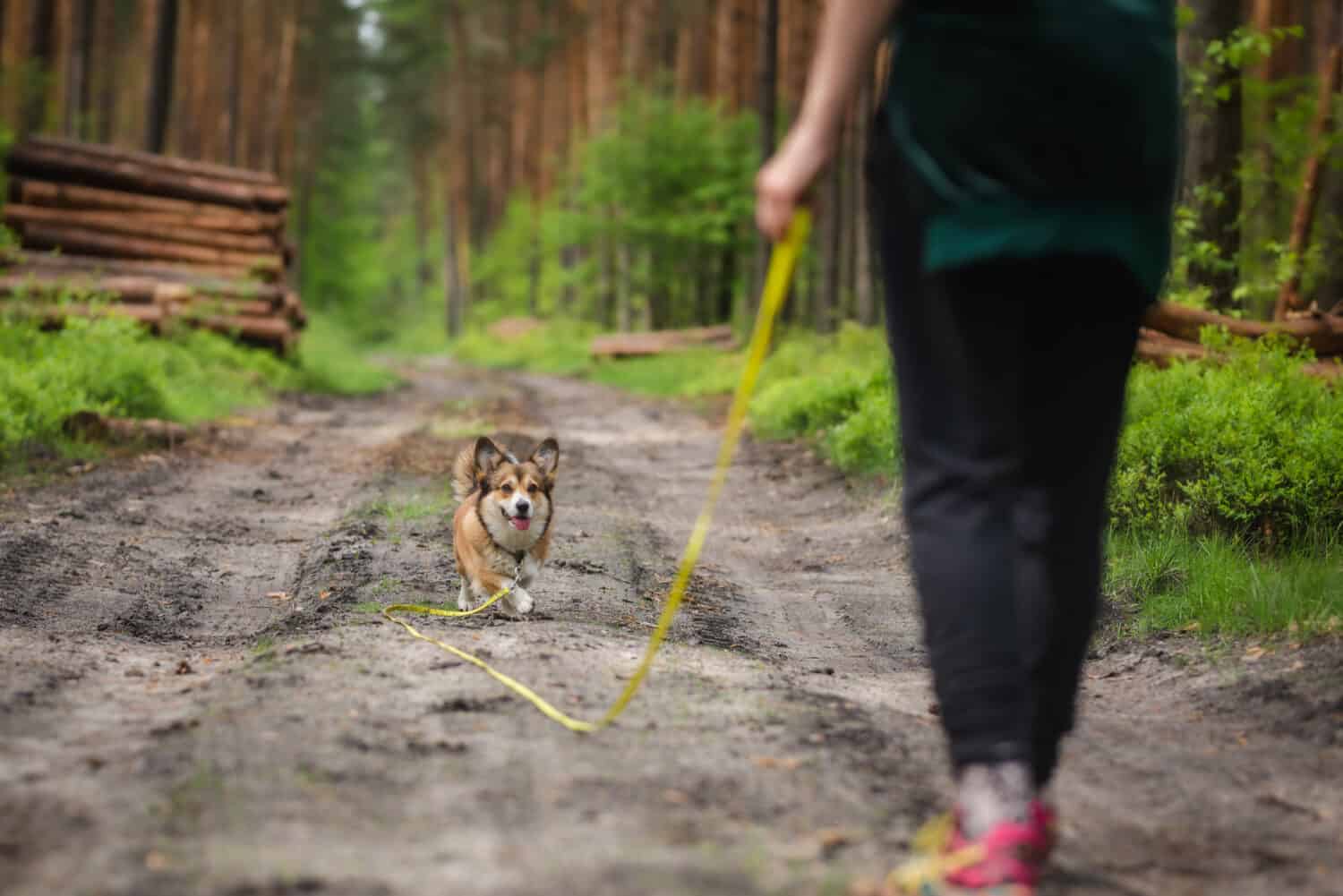
Teaching check-ins reduces pulling and increases connection on walks.
©Jus_Ol/Shutterstock.com
Leash Training: Walking Next to You
The other skill that you can start teaching your pup is to walk next to you. Some folks expect their dogs to walk directly next to them at all times, but as we mentioned above, this can be quite stifling for dogs and limits their ability to process the world around them. However, this skill can be extremely useful in navigating close spaces, crowds, and chaotic environments where walking next to each other is the safest option. So, essentially, this is a good safety and connection skill that you can use sparingly on walks and in other activities to ensure your pup can comfortably walk next to you when necessary.
To teach this skill, you can start on or off-leash in a low-distraction, comfortable environment. Carry a treat pouch with you filled with your dog’s favorite treats. Make sure the treats are cut up into tiny pieces as you’ll want to use a high rate of reinforcement. Simply start by offering treats for your dog standing next to you. Then, take a step together and immediately give your dog the treat at nose level with the dog. Your goal for these first few sessions is to slowly build up to taking several steps together and then offering a treat.
Long-Term Goals
The long-term goal is to walk on a loose leash together, positively reinforcing your dog at various intervals. Some dogs might need more consistent positive reinforcement for this leash skill throughout their life, while others may be happy to walk next to you with a treat offered every couple of minutes. Know, however, that if you don’t continue to reinforce this cue at some rate, the skill will likely fade as walking right next to you on the leash isn’t typically innately motivating for the pup.

Teaching your pup to walk right next to you is a useful skill, but we shouldn’t always ask our dogs to walk in this restricted manner.
©iStock.com/alexei_tm
Teaching a Change of Direction or U-Turn
The final skill we’ll talk about is teaching your pup a solid U-turn. Ensuring your pup is comfortable with quick changes of direction can help facilitate a smooth transition away from environments that may be unsafe or triggering to your dog. To teach a U-turn, you can start by facing one direction and then guide your dog with a treat to change direction. As they follow their nose, you can say “let’s go”, and then give them the treat as they turn around. Eventually, you can phase out guiding them with a treat and simply say in an upbeat, positive tone “let’s go”, change direction, and then reinforce your dog with the treat after they turned.
The photo featured at the top of this post is © Holger Kirk/Shutterstock.com
Ready to discover the top 10 cutest dog breeds in the entire world?
How about the fastest dogs, the largest dogs and those that are -- quite frankly -- just the kindest dogs on the planet? Each day, AZ Animals sends out lists just like this to our thousands of email subscribers. And the best part? It's FREE. Join today by entering your email below.
Thank you for reading! Have some feedback for us? Contact the AZ Animals editorial team.







